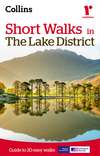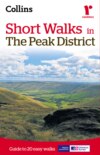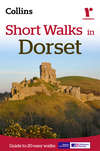Читать книгу: «Short walks in the Lake District»
Short Walks in
The Lake District

Guide to 20 easy walks
Contents
Cover
Title
Short Walk locations
Introduction
How to use this book
 Short walks
Short walks
walk 1: Round Loweswater
4 miles (6.4km)
walk 2: Round Buttermere
4 miles (6.4km)
walk 3: Derwent Water West Shore
3 miles (4.8km)
walk 4: Lodore, Watendlath & Ashness
4½ miles (7.2km)
walk 5: High Rigg
4½ miles (7.2km)
walk 6: Stonethwaite
4 miles (6.4km)
walk 7: Harrop Tarn
2 miles (3.2km)
walk 8: Aira Force
2 miles (3.2km)
walk 9: Glenridding & Greenside Mine
3½ miles (5.6km)
walk 10: Eskdale Ramble & Dalegarth Waterfalls
4 miles (6.4km)
walk 11: Devoke Water
3 miles (4.8km)
walk 12: Lower Duddon & Frith Hall
5 miles (8km)
walk 13: Blawith Common & Beacon Tarn
3¾ miles (6km)
walk 14: Torver Back Common & Coniston Water Shore
3½ miles (5.6km)
walk 15: Torver Low Common
2½ miles (4km)
walk 16: Glen Mary, Tarn Hows & Tom Heights
3 miles (4.8km)
walk 17: Tilberthwaite & Little Langdale
4 miles (6.4km)
walk 18: Holme Fell
4 miles (6.4km)
walk 19: Elterwater & the Waterfalls
4½ miles (7.2km)
walk 20: Orrest Head
2½ miles (4km)
Photo credits
Copyright
About the Publisher
walk 1, walk 2, walk 3, walk 4, walk 5, walk 6, walk 7, walk 8, walk 9, walk 10, walk 11, walk 12, walk 13, walk 14, walk 15, walk 16, walk 17, walk 18, walk 19, walk 20
Introduction

Walking in the Lake District
The Lake District has a huge variety of terrain for walkers of any age and ability which has helped to make it one of the most popular tourist destinations for over 100 years – low-level lakeside walks, exposed ridge walks, strolls through forests and thrilling mountain walks. Even at the height of summer when the towns and the more popular destinations are teeming with tourists it is still possible to get away from it all and find secluded areas where the magnificent countryside can be enjoyed in relative solitude. Always keep in mind that the weather can change rapidly and a lovely summer’s day can quickly change to a torrential downpour especially at higher altitudes. Scafell Pike at 3,209ft (978m) is the highest point in England and at 10½ miles (16.5km) in length Windermere is its longest lake.
Walking is a pastime which can fulfil the needs of everyone. You can adapt it to suit your own preferences and it is one of the healthiest of activities. This guide is for those who just want to walk a few miles. It really doesn’t take long to find yourself in some lovely countryside. All the walks are five miles or less so should easily be completed in under three hours. Walking can be anything from an individual pastime to a family stroll, or maybe a group of friends enjoying the fresh air and open spaces of our countryside. There is no need for walking to be competitive and, to get the most from a walk, it shouldn’t be regarded simply as a means of covering a given distance in the shortest possible time.
What is the Lake District?
What is seen now in the Lake District still reads historically from north to south. The mountains and hills of Skiddaw Slates which lie in a curving band, from the north to the west, are covered by carboniferous limestones and sandstones nearer the coast, and reappear to the southwest at Black Combe. Because much of this material is shaley and craggy outcrops seldom occur, the fells have angular outlines. Typically of course there is Skiddaw itself (3054ft/931m) with its neighbour Blencathra (2847ft/868m). The fells to the west of Derwentwater, Causey Pike and Grisedale Pike, are of the same material, and the rock is also very evident in the fells on the east side of Buttermere, to the north and west around Crummock Water and Loweswater as well as the northern end of Ennerdale Water. There is good soil depth on these rock forms which allows trees and heather to grow naturally.
In the central Lake District, roughly north-east to south-west are the high craggy fells of the Scafells, Great Gable, the Borrowdale fells, as well as Coniston Old Man in the south-west through the Langdales and Bowfell; and eastwards through Helvellyn to High Street. Here, the shallow acidic soils do not support a rich vegetation. The alpine plants are found mainly where springs leach the minerals to the surface. The deeper soils are often covered in bracken, very beautifully coloured in autumn, but useless to the hill farmers’ sheep. From another type of rock, formed from fine volcanic sediments in water, comes the famous green slate, still quarried and much in demand for its wearing and decorative qualities. It is used for the facings of prestigious buildings. The Honister Slate Mines on the Honister Pass closed in 1986 after three centuries of production. However, it reopened in 1997 as a working slate mine and has become one of the leading attractions in the Lake District.
In the south of the Lake District the soft slates and mudstones produce an acid soil in which trees and forests find root and regenerate quite readily. The typical scenery, much in evidence around Windermere, consists of rounded hills, often with a good deal of tree cover. The Forestry Commission’s largest forest, at Grizedale is also in this area.
Before there was a substantial human settlement the whole area was covered in forest. This has been removed over a period of 4,000 years. Much of it was destroyed from early Elizabethan times up to the end of the 19th century to provide charcoal for iron furnaces. The increase in sheep grazing has meant that regeneration has been impossible. Much of the woodland and forest we now see was planted within the last century and a half. The lack of tree cover in many places has accelerated erosion and impoverished the soil.

Geology
The history of the Lake District over the last 530 million years can be seen in the landscape at the present time.
The oldest rocks are the Skiddaw Slates. These were formed from sediments of gravel, grit and mud laid down in a shallow sea and later subjected to great pressure. Their age is usually put into the Ordovician period some 530 million years ago. Most of this rock series now resembles shale rather than slate. It is minutely jointed and with the action of weather and frost has broken down into small flakes.
After the deposition of the Skiddaw Slates came several millions of years of volcanic action. Lava burst out from below the surface and flowed over the landscape. Explosions threw out hot ‘bombs’ of rock. Ash settled to huge depths. All this mass of varied material settled to a depth of up to 2 miles (3km) and formed what are known as the Borrowdale Volcanic series of rocks.
After that the whole area was covered by a shallow sea, and erosion material, at first calcareous, then huge amounts of grit and mud settled in layers to a depth of 2½ miles (4km). This was in the Silurian period between 440 and 410 million years ago.
It can be imagined that the then lakeless Lake District consisted of three very thick layers of material each on top of the other. During the Devonian period the earth’s crust was subject to extreme movement. The area was thrust upwards into a dome. Each of the rock types reacted differently according to the position of the centre of the thrust. Once the upper layers were fractured, for instance, the more malleable Skiddaw Slate beneath was pushed through to a great height, then hot sandstorms and heavy rains wore down the upper layers. Much of Skiddaw Slates’ topmost parts, and a substantial area of the Silurian rocks were swept away. In the central parts the much harder Borrowdale Volcanics were left exposed. Therefore the Skiddaw Slates were left uppermost in the north, the Volcanics in the centre, and the Silurian to the south.
From 345 to 280 million years ago there followed the Carboniferous period. The area was again covered by a sea rich in life. The central part of the district probably remained as an island. The deposits in this sea formed the carboniferous limestone. Subsequently much of this was swept away leaving a rim around the Lake District. The Permo Trias period followed; the area became hot and arid. The desert sands of this time were later solidified into the New Red Sandstone, which again was mainly swept away from the central dome.
The Tertiary period, 65 million years ago brought new upheavals to the planet. This ‘Alpine’ movement produced the Alps, the Himalayas and the Andes. Again the Lake District’s dome was raised high. Fracture lines appeared, in general radiating from the centre, but varying in direction according to the reaction of the material. These formed the basis of the valley patterns we know today.
The next great catastrophe was nearer our own time. About one a half million years ago the climate changed dramatically and the whole of the northern hemisphere was covered in ice. The subsequent movement and melting of the ice hollowed out the valleys and lake beds, and swept away vegetation. The heavy rainstorms later moved any remaining loose material. Thus the dales were sculpted and the lakes were formed.
Wildlife in the Lake District
Because of the huge variety of landscapes to be found in a relatively small area, there are diverse habitats for flora and fauna to thrive. Many different types of grassland, upland heath and mires are designated areas of habitat conservation and protected plant species include juniper and the slender green feather-moss. There are several National Nature Reserves, over 100 Sites of Special Scientific Interest and many other conservation areas.
There are different types of grassland to be found, the species supported being determined by the quality of the soil and the climate. The old fashioned hay meadow is rich in various species of wild flowers and butterflies.
The moorlands of the mountains and fells are carpeted in plant species such as heather and sphagnum moss, commonly called peat moss due to its abundance in bogs and mires. Red grouse can be found on the moorland.
The Lake District supports several endangered species of fish. The vendace was to be found at 4 locations in Britain – two in Scotland and in Bassenthwaite Lake and Derwent Water. However there has not been a recorded sighting in Bassenthwaite since 2001 and they have died out on the Scottish lochs leaving only Derwent Water. The schelly is still to be found in Brothers Water, Haweswater, Red Tarn and Ullswater, and the arctic char, which, although still rare, is a little more commonplace being found in several of the lakes. Cormorant nesting was prevented by repeated disturbance in 1999 and 2000 in Haweswater in an attempt to protect the schelly. Goosander, goldeneye, tufted duck, dipper, grey wagtail and sandpiper can be seen on the lakes and waterways.
The Environment Agency introduced new fisheries bylaws in 2002 regarding the use of freshwater fish as bait in an attempt to protect the fish stocks. The introduction of non-native fish can lead to devastation of native species because of competition for food and spread of disease. A major problem has been found with ruffe which eat the eggs of vendace – they have a long incubation period and are therefore particularly vulnerable.
Numbers of native red squirrels have been dwindling throughout Britain over the last 100 years ever since the grey squirrel arrived from North America. They are more timid and smaller than the greys and lose in the competition for food. A sighting is always an exciting occurrence.
In 2001 ospreys returned to the Lake District after 150 years. A pair spend their winters in Africa but have returned each Spring since then to breed on the hillside around Bassenthwaite Lake. There are now two viewpoints at Dodd Wood north of Keswick, as they recently moved the site of their nest to the opposite side of the lake – a very unusual occurrence as the same site can be used by generations of osprey.
Haweswater was home to England’s only pair of Golden Eagles but the female disappeared in 2004 and has not been seen since although sightings of the male are still made.
Бесплатный фрагмент закончился.
Начислим
+6
Покупайте книги и получайте бонусы в Литрес, Читай-городе и Буквоеде.
Участвовать в бонусной программе















